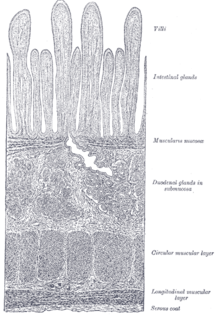Brunner's glands

The Brunner's glands ( glandulae duodenales ), also known as Brunner's glands , are mucous glands with branched tubuloalveolar gland tubes made of single-layer cubic epithelium that open into the crypts of the duodenum (duodenum). They lie below the lamina muscularis mucosae in the tela submucosa and break through it.
The glands were first described in 1679 by the anatomist Johann Jakob Wepfer . However, it was not until the description made by his son-in-law Johann Konrad Brunner in 1687 in De glandulis in duodeno intestino detectis that received greater attention, so that Brunner was considered the discoverer of the glands named after him.
function
The glands secrete a glycoprotein-containing , alkaline mucus that neutralizes the acidic food pulp from the stomach. They also produce proteolytic enzymes (e.g. enteropeptidase = enterokinase) as well as amylase and maltase . If the enzyme content is reduced, the absorption of the food components is also reduced, which can lead to severe malabsorption .
literature
- Theodor H.Schiebler (Ed.): Anatomie . 9th edition. Springer, ISBN 3-540-21966-8 , pp. 574-575 .
- Ulrich Welsch: Textbook Histology . 2nd Edition. Urban & Fischer, ISBN 3-437-42421-1 , pp. 377-378 .
- Axel W. Bauer : Brunner glands. In: Werner E. Gerabek , Bernhard D. Haage, Gundolf Keil , Wolfgang Wegner (eds.): Enzyklopädie Medizingeschichte. De Gruyter, Berlin / New York 2005, ISBN 3-11-015714-4 , p. 216.
Individual evidence
- ↑ Axel W. Bauer: Brunner glands. 2005, p. 216.
